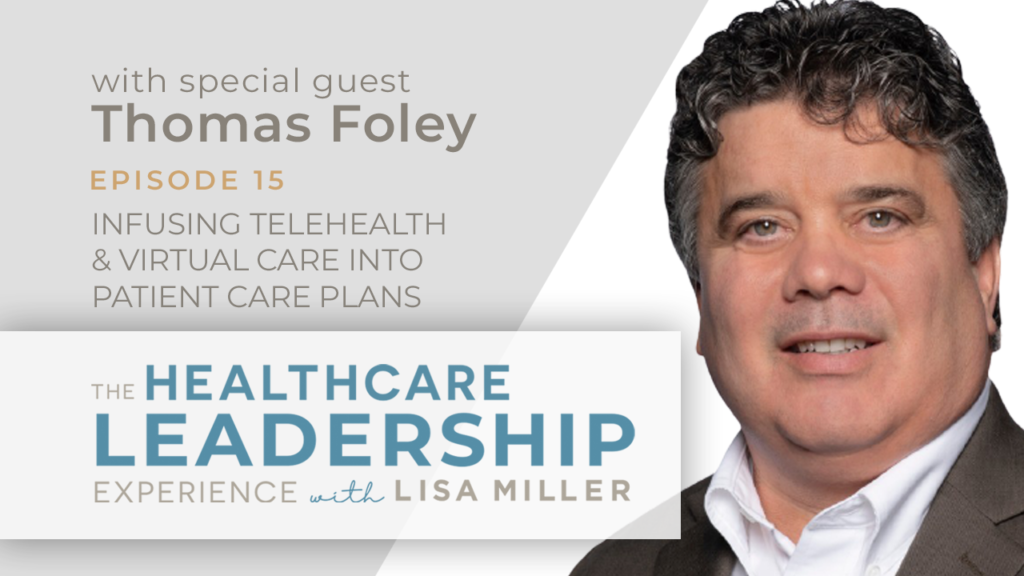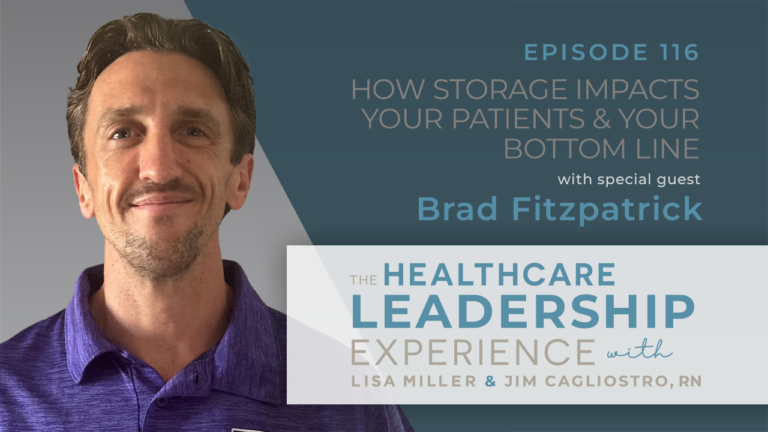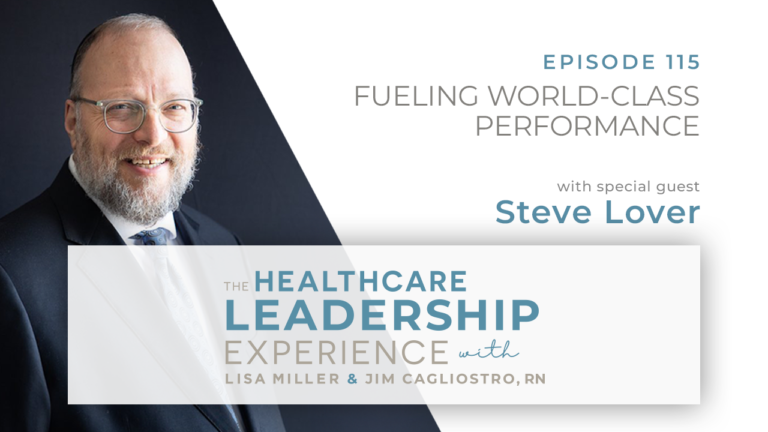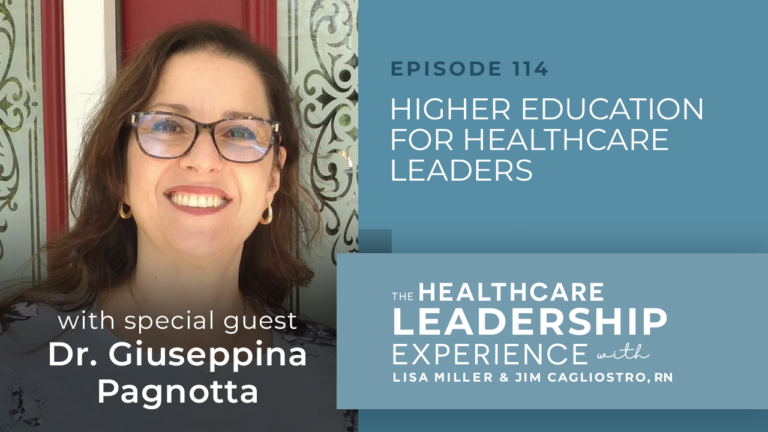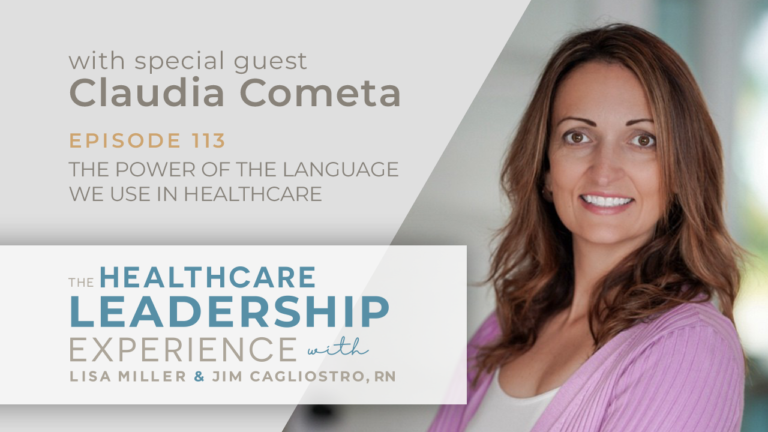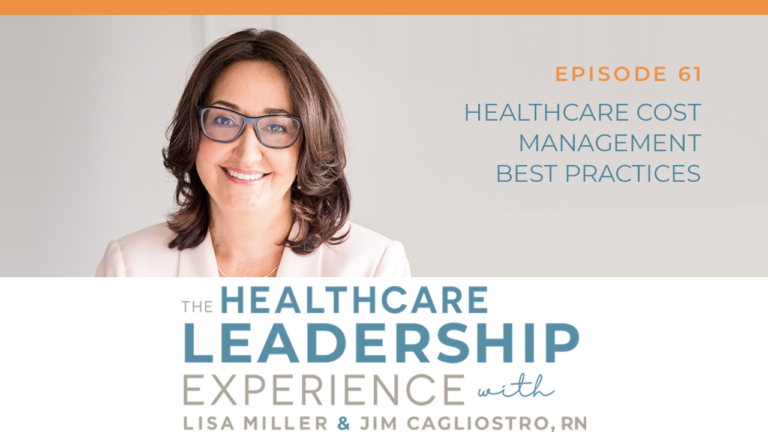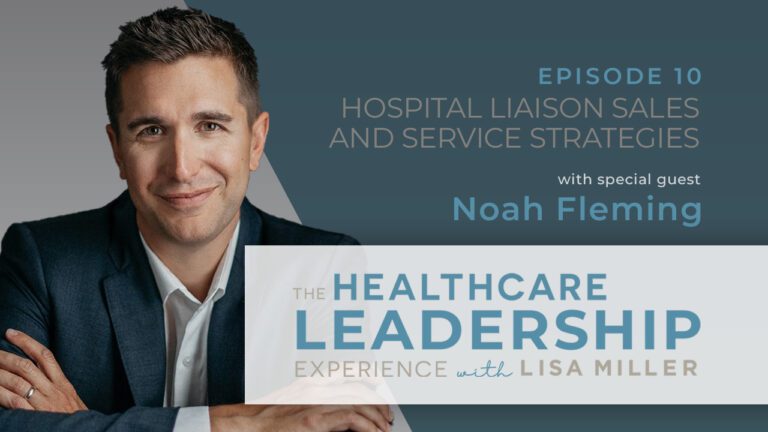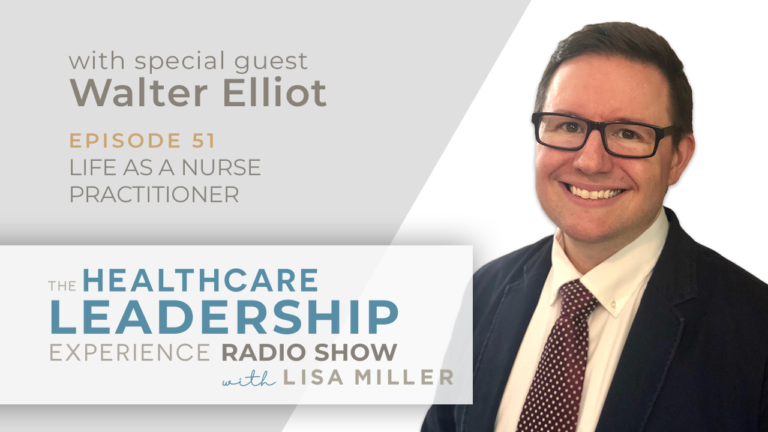In Episode 15 of The Healthcare Leadership Experience, Lisa is joined by Thomas Foley.
Thomas is the Chief Growth Officer at GenieMD and host of The Virtual Shift: Reimagining the Delivery of Care. His expertise is virtual care.
As Thomas asks, according to CDC data, patients only spend 15 hours in front of doctors in any given year, ‘’What happens to the other 8,745 hours?… That’s where wellness takes place.’’
This episode is sponsored by VIE Healthcare Consulting® which has proudly helped hospitals save $758 million since 1999.
In today’s episode you’ll hear:
The macro trends impacting US healthcare, for instance, six out of ten Americans have one or more chronic condition. ‘’It’s not whether we monitor them, it’s how we get them better.’’
The difference between care and wellness in healthcare today.
The vital roles of telehealth, remote patient monitoring and chronic care management in a unified virtual care collaborative platform.
The three continuums of the healthcare digital transformation journey and why hospitals need to reimagine virtual care. ’It’s not virtual care versus bricks and mortar care, it’s the blending of the two that will help you reimagine.’’
Why the roles of health coaches and care co-ordinators are essential to engage with consumers and bridge the gap in the patient experience.
The challenges to implementing a sustainable virtual care platform in hospitals, and why it’s important to start small. ‘’What is your goal? …What’s your end stage? …Does this unified virtual care collaborative platform support what you’re doing? Those are some of the questions I’d be asking if I was running a health system.’’
Why there is an urgent need to engage with the cost and impact of diabetes on healthcare in the US.
Discover the one key area of investment to infuse a virtual care program into your hospital or health system and engage every patient on a ‘’path that takes them to wellness.’’
CLICK HERE TO DOWNLOAD THE PDF TRANSCRIPT
Resources:
https://www.cdc.gov/chronicdisease/programs-impact/pop/diabetes.htm
https://www.linkedin.com/in/tomfoley/
Connect with Lisa:
📱https://www.linkedin.com/in/lisamiller/
CLICK HERE TO OPEN THE FULL TRANSCRIPT
Tom Foley (00:00):
One that has five chronic conditions, they see nine different doctors in a given year. They only spend 15 hours in a given year in front of their doctor. So, the question I always ask is, what happens to the other 8,745 hours? That’s really where wellness takes place. So, when we look at virtual care, we look at telehealth, it has its place, has its value. And then there’s remote patient monitoring and then chronic care management. So it’s the whole continuum that really needs to be embraced if that home is gonna be becoming a setting of care. How does this unified virtual care collaborative platform support what you’re doing? Those are some of the key questions that I would be asking if I were a health system.
Announcer (00:48):
Welcome to the Healthcare Leadership Experience, a place where healthcare leaders will share proven strategies and innovative approaches to leading the clinical and business side of healthcare. This show is sponsored by VIE Healthcare Consulting, who’s proudly helped hospitals save over $700 million in non-labor costs since 1999. Here is your host, Lisa Miller, founder and CEO of VIE Healthcare.
Lisa Miller (01:11):
Hi, this is Lisa Miller, and I’m the host of The Healthcare Leadership Experience. Welcome to today’s show. We have a special guest, Tom Foley, who’s the chief growth officer at GenieMD. He’s also the host of the Virtual Shift, Re-imagining the Delivery of Care. His expertise is virtual care, so we’re gonna have a great conversation today about telehealth, telemedicine, remote care monitoring, and the ways hospitals and other providers can infuse telehealth and virtual care to help patients on their journey to wellness.
So, let’s get started. Welcome, Tom Foley. I am so excited to have you on the Healthcare Leadership Experience.
Tom Foley (01:55):
Thank you. I appreciate it. Thanks for the invite.
Lisa Miller (01:57):
You’re doing some great work on the telehealth and telemedicine part of healthcare, and I’m just gonna jump right in and have a discussion.
Tom Foley (02:06):
Awesome.
Lisa Miller (02:07):
I had the opportunity to be on your podcast, so, everybody, I think you have to also listen to Tom’s podcast. He’ll provide you with that information at the end of the show, but I really enjoyed that. So, this is really Part Two.
So, I just wanna lead with the fact that you do a lot of talking and presenting about telehealth, and you have a macro trends slide that you speak from. So, I’m just gonna talk for a couple of minutes and then, and really just wanna get your feedback, Tom. You talk about 382 million people globally have chronic diseases, and I really wanna get to what’s going on here in the U.S. and what really is the issue here. And then, I wanna hear how you think we can tackle this with telehealth and, as well as diabetes. I mean, diabetes is the number one most expensive chronic condition in the U.S., so I’d love to get your feedback on that.
Tom Foley (03:04):
Yeah, so I look at the, well, you mentioned the macro trends. It doesn’t matter what geography you’re from, the macro trends are all consistent. So we have a growing population, no one would, uh, doubt that. We are aging. Sixty-five and older, that population is growing more and more, uh, longer life, and to your point, and they’re developing more and more chronic conditions as they get older. But the, and the problem with that is we have less physicians and nurses available to take care of that growing older age or sicker population.
As far as the U.S. is concerned, six out of 10 adults have one or more chronic conditions. And so, the question is not whether or not we should monitor them. The question is how do we get them better?
Lisa Miller (03:04):
That’s right.
Tom Foley (03:47):
And, and there’s a huge, uh, distinction there. So, I always talk about those patients with two or more chronic conditions. Uh, I always use the example of one that has five chronic conditions, they see nine different doctors in a given year, this is all through, uh, CDC data. They see nine different doctors in a given year. They only spend 15 hours in a given year in front of their doctor. So, the question I always ask is, what happens the other 8,745 hours? That’s really where wellness takes place. Care takes place when you’re in front of the doctor, wellness takes place because I decided, as the consumer, as a patient, that I’ve obviously become aware, [inaudible 00:04:34] talking with my doctor, what the state of my health is, and what am I gonna do differently?
And it’s at home that makes the most difference. I can, uh, unfortunately, had the, had the need to take care of, uh, many loved ones. One was my father, who had diabetes, and you know, diabetes doesn’t hurt until, until the, uh, end stages. The point there is my father was obese, had diabetes, had kidney failure, so he was doing a lotta stuff at home. The bottom line is that in the last five years, ’cause he didn’t pay attention to his diet, he drank Coke, a Diet Coke, but that was about it. But, you know, it didn’t help anything. But the last five years, he had one leg amputated, then the second leg amputated, then an arm amputated, and then two fingers on the other hand amputated.
So, care in the home and watching the dining room become a bedroom, and having to add a bathroom, a full bath, downstairs, I know all too well what that scenario is. And if you don’t have loved ones that are embraced in making sure that you’re taken care of, it becomes even harder for that, uh, elderly person.
So, it’s a very challenging scenario and I’ve, uh, been saying as of late, just because you get diagnosed with Type 2 diabetes doesn’t mean you have to die with it. There’s many things that we can do when you have a chronic condition that could turn you north in, in the context of, on that awareness to wellness continuum.
Lisa Miller (06:07):
Can I talk about that, awareness to wellness, which you talk about, and we’re gonna get to that in a minute. When I was doing research today, I was reading really about how the role health providers addresses diabetes, because I feel like they had no choice but to really utilize telehealth and really pre-COVID, they were really more on the forefront or allowed to use telehealth and telemedicine. So, it was interesting. There’s three aspects. It’s, of course, it’s diabetes self-management, it’s medication adherence, and it’s especially care and consultation.
So, in the context of that, I love this idea of infusing education, and part of their methodology is education, right? It’s helping patients, giving them the information they need as well, whether it’s phone apps, use text message for medication reminders, phone apps for management, for education. But, there’s so much we can do with telehealth and telemedicine that can get that patient well again. And, really, this is your expertise, Tom. You’re the chief revenue officer at GenieMD, and you see a lotta this. You, you’re very innovative in your company and how you address these issues. Can you talk a little bit about those aspects of how you would infuse telehealth into a chronic condition like diabetes?
Tom Foley (07:31):
Yeah. Actually, I’m just gonna step back one real quick second. We often refer to it as virtual care.
Lisa Miller (07:36):
Okay.
Tom Foley (07:37):
Because telehealth has this, especially since COVID, has this connotation that it’s a video visit, right?
Lisa Miller (07:43):
Mm.
Tom Foley (07:43):
It’s a very narrow window of what telehealth does, right? Uh, so, you know, the video conferencing organizations, uh, such as Zoom and Microsoft Teams, and things of that nature, folks might think that, uh, of themselves, uh, even Facebook and, uh, Facetime, think of them as a telehealth platform. They are not, in the context of the larger view of how do we engage a patient in their home, and that home being a setting of care?
So, when we look at virtual care, we look at, certainly, telehealth. It has its place, has its value. And then there’s remote patient monitoring, and then chronic care management. So, it’s the whole continuum that really needs to be embraced if that home is gonna be becoming a setting of care, whether it be for ambulatory reasons or, you know, the hospital at home type of use case.
So, let’s just jump into remote patient monitoring, right? You could have diabetes, you could be, your provider could, uh, prescribe you into a remote monitoring program for diabetes. But are we there to help you manage it, or are we there to help you get rid of it? In my view, that’s the big question. We can help you manage it, but so we’re, uh, addressing the symptom and not the problem, right? So, uh, diabetes, uh, if you’re obese, uh, like my father, sometimes if you have that condition because you’re not exercising, you’re not dieting. People need other people to lean on when they need, uh, help.
And so, that health coach, that care coordinator, often becomes, uh, an educator and a coach role to things that they should be doing. And so, we can monitor that your glucose level is good every day, it doesn’t come outside the range, so a thumbs-up for you and that’s good stuff. Right? You’re not eating the jelly donuts as often as you used to. That might be a good sign. But are you losing weight? Are you exercising? There are other things that you can do that could help you along, again, that path to wellness. Wellness sometimes means you’ve gotten rid of that chronic condition and you know how to manage yourself accordingly.
I always use the show, uh, The Biggest Loser, as the exaggerated point of, I walk onto the show with a bag of pills because I have diabetes and I have every other condition imaginable, and I walk off the show empty-handed because I learned how to diet, I learned how to exercise and I learned how to manage myself. And they got in a different head space, uh, relative to who they are and what they can achieve. And that’s a really powerful role to the ultimate purpose of a deliberate care organization, in my view.
Lisa Miller (10:24):
Yeah, absolutely. You talk about a healthcare digital transformation journey. Can we talk a little bit about that? In terms of, you know, the work that I do within hospitals is supporting hospitals, and whether it’s, you know, cost innovation, costs savings process improvement and those things, and so we’re learning to really be innovative in how we, uh, utilize virtual care, which I love better, in so many different ways, there’s so many aspects you can im-, put that on the patient journey. Can you speak to a little bit of the, how you see the patient journey and virtual care and s-, the opportunities that exist for hospitals?
Tom Foley (11:03):
Yeah. Great question, I appreciate it. And the journey is, we all have to remember that every consumer, every patient, is on a different journey. So, a health system’s ability to be nimble and be able to flex in the context of uniquely supporting each patient relative to their unique journey. Not every person with diabetes, not every person with hypertension, is, uh, not basically the same. But that said, I talk about three continuums and I try to merge that into a healthcare digital transformation journey.
Ultimately, we wanna get from an institutional-centered care to a health consumer-centered care. And the first continuum I talk about actually begins with COVID. And while there was the, people don’t remember, but before COVID, there was a lotta good stuff going on. One of them was transitioning to a value-based care model versus an episodic care model. But at COVID, you know, we had to suddenly think differently as a healthcare system. My doors were locked. I had no access. My patients had no access. So, that’s how virtual care sprung into action, and it helped solve a lotta problems. It didn’t fix every problem but, at the end of the day, health systems had to respond. And then they realized, hey, Mikey likes it. You know, uh, for those that remember that commercial long ago.
Lisa Miller (12:21):
(laughs)
Tom Foley (12:21):
Uh, you know, at the end of the day, the doctors loved it and the patients liked it. So now, they’re starting to rethink, how do we use this tool to re-imagine the delivery of care? It’s not virtual care versus brick-and-mortar care. It’s the blending of the two that will help you re-imagine. So, the provider starts to adopt this virtual care model and there’s, uh, again, based on the need to engage the patient, you could engage them in many different ways, asynchronously, synchronously through a video engagement.
You can have what they refer to as a high acuity encounter, maybe the, uh, patient has a medical device that’s integrated with the virtual care platform, and the doctor could be on the other side of the Internet while the patient is holding the stethoscope or taking vitals and, or the otoscope. So I can stream video, I can stream audio and I can stream data to that doctor in real time, whether it’s me with the medical devices or a nurse that came to my house, one of the two. But that data, I could do a full encounter and I don’t have to leave my house. And it’s just as much as what happens when you go into a brick-and-mortar facility. And then, it ge-, uh, it moves up into remote patient monitoring and so forth and so on. Is, the question is, how do I maximize the pa-, provider in all of its toolsets, how do I maximize my ability to, or my population, to be well?
What I talk about in the last continuum is really about the patient. If a provider needs to get to value, a patient has to be aligned with that provider on an even understanding that if you go to a, I talk about this all the time at, at the dinner table with friends and, and family and things of that nature. Yes, someone that’s not in healthcare, whether or not they understand value-based care and they don’t even know, right? So, the point is that if I don’t know as a consumer that a provider’s incentive on value-based care, and I’m not gonna respond or I’m not gonna react to the awareness that he brought to my attention that I have a chronic condition and do nothing, then the doctor’s not gonna get the value.
So, it’s gotta be a collaboration between the doctor and the patient as to, how do we get to wellness? Because we both wanna get there, and they both benefit from it but, because they’re so disconnected sometimes and the patient, again, is only in front of the doctor 15 hours in a given year, I’m gonna go home and I’m only gonna go see that doctor in three months. Well, what happened in the three months?
You know, I was talking to someone the other day and they said, uh, it was a doctor actually, and they said sometimes a person with hypertension will calm themselves before they go to a patient visit so that the blood pressure is normal. But that doesn’t reflect what is normally happening in the other 364 days in a given year for that patient, right? So, it’s a false reading. What, just because you took a vital in front of the doctor once a quarter doesn’t mean that that’s reflective of the full experience of, of the patient throughout the year.
So, that’s why, to fill the gap ultimately, we need these health coaches and these care coordinators to engage with them. And I always think of remote patient monitoring as the, and prime care management, as the way to fill the gap, the, the other 8,745 hours in a given year. The solution is remote patient monitoring and chronic care management, and is hopefully soon to be remote therapeutic monitoring. Those are very powerful tools that can be leveraged to get that patient to wellness in concert with the provider’s need to provide value-based care models.
Lisa Miller (16:11):
So, I love that information, because it was just packed with so much (laughs) that I wanna just also take a step back for a minute, because you would think because virtual care, in blending with care that’s either in the hospital or in the physician’s office or another setting, that blending makes a lotta sense. You know, what do you think has been the challenges of real full implementation or a hospital just saying, “We’re gonna be completely innovative. We wanna know every single point of entry where we can bring in virtual care.” What do you think the challenges are from a hospital perspective and then, I can give you some of my thoughts as well?
Tom Foley (16:50):
Yeah, I’d love to hear your thoughts as well. And it is a challenging one, because there’s so much noise out there. I think that one of the biggest challenges is breaking through the noise. What is really, uh, best for me as a health system versus buying into an incomplete model? Videos, conferencing services coming through as a virtual care or telehealth platform, right? It’s only part of the solution. I still have to piece together other elements that are not integrated, uh, with the larger picture. So, the challenge here is for health systems to think first about what’s the goal and what are the different types of services that we wanna provide at the end stage? Let’s think three years out and then look at all the different pieces so that when you adopt something, you know that that platform can support you long-term. You might start small, which you should, and, uh, frankly, just to make sure you’re getting it right, and expand as you go.
I always talk to health systems about the ability to scale across the community. What’s that mean? You know, I always look at health systems as the hub of the community in, in many respects. And that hospital system supports many different entities. They support not only the consumer that comes in for services, but do they support the consumer at home? And they support the school. They support employers, correctional institutions, [inaudible 00:18:19]. You name it, they become the core of that community from a healthcare perspective, so how do I reach out to all those different unique constituents and provide a very unique service for them?
So, I need to be able to scale across the community and be able to uniquely support the needs of every patient who’s on a separate journey, right? So, your platform should be inclusive of telehealth, remote patient monitoring, chronic care management, and you might wanna start asking what are you doing in the context of remote therapeutic monitoring. Right? And how does this unified virtual care collaborative platform support what you’re doing? That, those are some of the key questions that I would be asking if I were a health system.
Lisa Miller (19:08):
Yeah, absolutely. I a hundred percent agree, and I think that some of the challenges we see and that we support our hospitals with is really finding out where those gaps are. You know, are there challenges where they need to infuse some extra care? The virtual-
Tom Foley (19:08):
Yeah.
Lisa Miller (19:23):
Care can be put right into that at discharge, right? Or the next day after discharge. It’s the, really, it’s the readmissions and looking at those 30 days, and how they could be very disciplined and thoughtful about a virtual care strategy. Uh, those higher cost patients or populations or the elderly or, or ways that they can just invest in virtual care for the protection, also, of, you know, whether it’s the elderly or chronic care.
And also you mentioned earlier, we do have a shortage and then we have, uh, you know, a COVID crisis, so we have an overburdened system. And I think that that’s a challenge to then spend time to figure out some of this virtual care opportunities, because there’s really no time. But they need to, because they don’t have the ability to really care for everyone the way they’re doing it. So, that change management aspect is so important.
But I say start small, pick some obvious places and pick some places that aren’t so obvious. You know, like you may have your patient satisfaction coordinators or there, there could be CNOs or care coordinators or, or people throughout the system that said, you know what? There’s an issue that’s repeated and we think if we added, uh, virtual care follow-up, a text message [inaudible 00:20:45], or health coach like you’d said. I actually think that they would get an excitement, they’d get some wins and the more wins, you build momentum. And now, you really have a full blown program. And marketing. We’ve gotta get these messages out to the community, like you said, and tell the community, you know, use our virtual care platform. Give us suggestions. But I think there has to be that community communication as well.
Tom Foley (21:11):
Yeah, I couldn’t agree with you more. The idea of starting small and incremental growth, incremental wins, incremental successes, it is very important. You don’t wanna roll out a virtual care platform all in one day. You’re just not gonna be successful, right? There, there’s just too much to do. And what’s your program for readmittance? What’s your program for reducing ED visits? Your diabetes program, your respiratory program. And again, it goes on and on and on. So, uh, it involves the entire organization, uh, but it needs to be segmented in its implementation so that you can maximize your success [inaudible 00:21:54].
Lisa Miller (21:53):
So, uh, we have, uh, still a few more minutes left and I, I wanna go back to diabetes, only because it, it’s more from an informational perspective, and those who hear my podcast or hear webinars and videos know that I really like to dispense data and information. So, if you don’t mind one second, Tom, because I feel like this in an area where, you know, we can provide the audience with some really compelling information. And then I wanna talk about your work in your organization at GenieMD, and I’ve just got some questions around there. So-
Tom Foley (22:26):
[inaudible 00:22:26]
Lisa Miller (22:25):
From my audience, you know, I do think that as hospital leaders, the issue with diabetes is really a problem that we’re going to have to solve, for many different reasons. And so, I think it’s its biggest opportunity to think about how you could use virtual care. And it’s interesting, you know, the CDC has quite a bit of information around the high cost of diabetes, but the overall economic cost of diabetes rose 60 percent from 2007 to 2017. There are some simple ways to, even like Tom mentioned you know, it’s not just wellness, but can we make changes? I mean, it’s about blood sugar management and it’s about getting patients to come in and do things like regular eye exams or foot exams or detecting early treatment for diabetic kidney disease.
There’s a lot of things that we can do on the preventive side but, like Tom said, you have the monitoring, you have a coach. Because this, this will help reduce emergency visits or those, you know, additional comorbidities, things that complicate the care when patients come into the hospital. So, for my audience, I do have, and I’ll put this on our website, it’s a nice document about diabetes interventions from the CDC. I wanna pass it on to everyone. But that being said, can you speak about your work at GenieMD and what your organization, your company, does on the virtual care, and who you support, Tom?
Tom Foley (23:56):
Sure. I appreciate that question, and if I could just, the diabetes, uh, issue, I would employ everyone to engage this topic I am just so, uh, passionate about. There’s so much we can do in that particular space if we just took it another mile in the context of, uh, a different level of service, uh, to our loved ones.
So, you know, GenieMD, I am the, uh, chief growth officer and so, we are very much involved in, uh, virtual care, uh, delivery. Uh, actually, GenieMD actually has two sides of its organization. The one side is that we do provide urgent care services through the GenieMD Medical Group. So, we understand healthcare because we deliver it. We have 650 providers nationwide, so we understand the urgent care matters within the delivery of care.
There’s some challenges with that and I’ll be frank and say that we need to do a better job in how do we connect an urgent care service to the overall continuity of care, relative to who that primary care physician actually is, and the local health systems so that information is more readily available? But that said, GenieMD also provides a full, unified virtual care collaboration platform, in supporting all of what I said earlier. Telehealth, asynchronous and synchronous, high acuity encounters, as well as remote patient monitoring services, chronic care management, and we are working on remote therapeutic monitoring.
So, it’s one platform. We have a plethora of medical devices that we support a lot, meaning over 400. However, we typically have supported, uh, you know, the best in class. One of our partners, as an example is, AliveCor. They do the EKG within the fingertip as one example. CMI Healthcare, relative to, uh, vital, uh, vi-vital captures and re-respiratory devices in the home, and many more.
And then we also integrate with the EHRs. Those are the, that’s the fundamental core of a virtual care platform, all the different services that it can provide, but yet, how do I share this information across the community of care so that we remain in-sync? The patient, ultimately, has the ability to read, every health encounter that they have is recorded and the patient can come back to the, to the iVisit platform and see all their health records. They can see, uh, educational content, and they can use that as even, uh, a sounding board for some assistance.
So, when we sell that platform, we typically sell two hospital systems, large and small, we engage self-insured employers, schools, and skilled nursing facilities. So that that’s really the core audience that we target, and we do so by white-labeling our platform. Other than our urgent care services, everything that we do from a platform deployment has been white-labeled to the local community, because as I said earlier, they are the hub of the community. There’s no need to inject the GenieMD brand, because we want that health system to be the one to shine, and so there’s no confusion as to where the services are coming from. So, that is kind of the GenieMD in a nutshell.
Lisa Miller (27:07):
Well, thank you. (laughs) I just wanted everyone to hear the great work you’re doing over at GenieMD and, uh, you know, it’s important for us here at the Healthcare Leadership Experience Show to bring value to our listenership, to our hospitals. And, and to give them resources, um, to reach out to our tools and, and they can th-, you know, they can think about or compare, maybe. You know, just have a conversation, a call with you. So, I appreciate you being on this show.
As we wrap up, if you could give our audience maybe one really spectacular area of opportunity for them to kind of infuse telehealth virtual care.
Tom Foley (27:47):
I think the one opportunity that needs to be invested in is the remote patient monitoring side of the equation. Let’s engage those patients in their home, let’s take their vitals frequently throughout the month and engage them in a program that moves them on that path to wellness.
Lisa Miller (28:05):
So, I have to a hundred percent agree. I think that’s the most underutilized aspect of virtual care. My mom is on a remote monitoring program and I just think it’s fantastic. And it allows her primary care to see her blood pressure, which is good in her case, but she’s also had it for some heart monitoring. But she’s gotten calls, she’s gotten check-ins, come see me, and it’s, really has, number one, it’s accountability, too. Like, okay, somebody’s watching, you know, you know, it’s accountability, which is good if there’s a behavioral component. But, two, there’s a real great component of watching patients a-and seeing a trend that, as it’s about to happen before it goes in a bad direction.
I, I think remote monitoring is something that every hospital should have a program and, again, test it out, particularly on discharge or their patients that you just wanna stay connected to. I, I think the results, the investment in that program, the results will be just tremendous. So, I couldn’t agree with you more, Tom. Thank you for being on the Healthcare Leadership Experience Show. And I, uh, look forward to seeing all the great things you’re doing over in, uh, GenieMD. So, thank you for being here.
Tom Foley (29:21):
Awesome. Thanks for having me, and, uh, appreciate the opportunity to explore with you.
Leah (29:26):
Hi, this is Leah. You are listening to my mom’s podcast, the Healthcare Leadership Experience.
Fernando (29:33):
Hi, this is Fernando. If you would like to speak with my mom, just email her.
